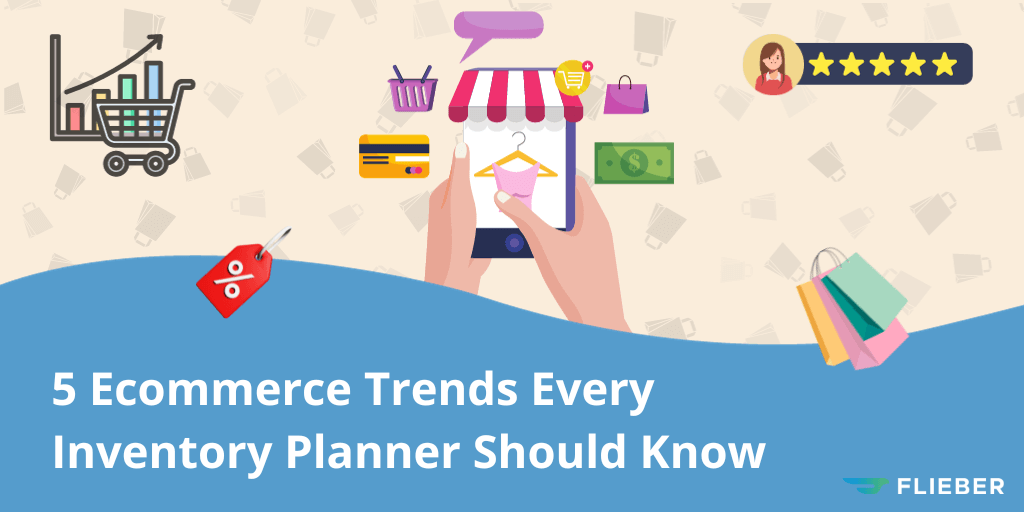The ecommerce world is changing faster than you can say “unified omnichannel experience."
Customers demand better visibility, stronger brand values, and compliance with key sustainability practices. Yet inventory stockouts and supply chain setbacks are still a regular (and expensive) challenge for modern retailers.
To scale successfully, brands need lean, agile inventory planning systems that can adapt to any demand fluctuation, market phenomenon, or natural disaster.
In this article, we’ve rounded up some of the top ecommerce trends that could have the biggest impact on your inventory, plus ways to protect your profitability as the landscape continues to change.
5 ecommerce trends that impact inventory
- Overnight viral products
- Social shopping
- Visibility over speed with delivery
- Sustainability and values-driven purchasing
- AI everywhere
What are the top ecommerce trends that could impact your inventory?
We dove into the latest insights from retail experts, industry research, and trending ecommerce topics to make some key predictions about the external factors that could impact your inventory in the near future. When your inventory is affected causing stockouts, your profits will take a hit.
Here are the top trends that we identified, plus practical tips to stay one step ahead.
1. Overnight viral products
“The rise in overnight viral products and brands from platforms like TikTok has changed the game for inventory management and order fulfillment,” says Dani Mechlowitz, founder and managing director of UK-based Delta Fulfilment.
He’s not wrong. In the first half of 2021, a viral TikTok recipe sparked reports of feta cheese shortages at stores throughout the US. While the reports were largely exaggerated, the real story is the fact that a viral trend can have a sudden and dramatic effect on the supply chain.
Take the brand-sponsored TikTok review of Elf’s Halo Glow Liquid Filter as another example. This single influencer review caused the product to sell out within three days. In a much scarier example, diabetes drug Ozempic gained viral popularity for off-label weight loss use, resulting in shortages for people who needed the drug to control their blood sugar.
Even if you don’t have a well-laid plan for social media marketing and influencer campaigns, you never know when the next viral trend could impact your inventory. To keep your sales flowing, you need to be prepared to capture unexpected surges in demand.
“This attention to your products or brand can bring in a lot of orders that you aren't ready for and although you could be sold out in minutes, the ship will have sailed by the time you get more stocks in,” explains Dani.
Here are some ways to prepare for unexpected inventory rushes:
- Factor marketing campaigns into your inventory planning calculations, alongside anticipated seasonal fluctuations and any current or potential supply chain setbacks where foreseeable (e.g., Lunar New Year, El Niño).
- Use AI tools to help predict the right amount of safety stock to keep on-hand.
- Consider the cost of warehouse space versus the cost of potential stockouts, to avoid overspending on storage as you prepare your buffer stock.
A modern inventory planning platform can help you understand the seasonality in your forecasting data so you can improve your forecast accuracy and estimate the most capital-efficient amount of safety stock, without relying on error-prone spreadsheets.
2. Social shopping
Mobile commerce is predicted to account for over 40% of ecommerce sales in 2024, with payment apps and mobile-optimized sites spurring more and more purchases made directly from shoppers’ smartphones and tablets.
TikTok finally launched its long-awaited TikTok Shop product, which has already enrolled over 200,000 sellers. And while Meta has pulled back some social shopping features, it has also leaned more heavily into courting advertisers, revamping its ad formats, and integrating the shopping experience with other key social media features.
The rise of social shopping means more sales. But it also means more channels for brands to keep up with. In the future, a smooth omnichannel experience will require deeper levels of inventory insight.
According to Graham Grieve, marketing expert at Agency A1 SEO, this kind of omnichannel retailing “requires a unified view of inventory across all channels.”
“It ensures that whether a customer is shopping in-store, online, or through social media, they receive a consistent experience, and the product is available,” he explains.
To make the most of social commerce:
- Invest in sponsored ads and paid social search to increase visibility with your target demographics, along with any influencer marketing campaigns.
- Consider opening a TikTok shop or selling directly through another social media platform.
- Utilize inventory planning solutions that help you make confident decisions as you expand to new channels.
Brands that adopt sophisticated, comprehensive methods of inventory analysis and replenishment will be able to offer a more reliable experience across each new channel.
3. Visibility over speed with delivery
Costs associated with shipping are likely to continue rising, spurred in part by ongoing labor trends. To stay competitive, brands may need to diversify their shipping options and look to alternative carriers and services.
The good news is, while customers still generally expect same-day, next-day, and two-day delivery on certain orders, many are willing to sacrifice a certain amount of speed in exchange for free shipping and more reliable delivery. And many solutions are cropping up to solve exactly these problems.
Customers often want visibility and control more than they want fast-as-possible delivery. They also want perks like live order tracking and the ability to redirect or reschedule a delivery, with 96% saying they want to see GPS order tracking.
“Consumers don’t necessarily care [how quickly] something is going to be delivered,” Melissa Minkow, director of retail strategy at CI&T told Supply Chain Brain. “They’d rather know accurately when it’s going to arrive.”
Retailers also want greater last-mile visibility, with 61% saying it’s their top challenge when scaling delivery.
To improve last-mile visibility internally and for your customers:
- Partner with innovative 3PLs, alternative shipping carriers, and other last-mile delivery solutions that offer visibility perks like real-time order tracking, delivery rescheduling, and direct communication with couriers.
- Use supply chain visibility technologies that integrate seamlessly with last-mile partners.
- Offer customers a range of delivery options, from slower free delivery to premium shipping options, with a tiered pricing structure.
Brands can also offer customers the option to pay a little extra for priority order processing so that their orders are picked and packed ahead of the queue, regardless of shipping option.
4. Sustainability and values-driven purchasing
According to a 2022 Harris Poll study, a whopping 82% of shoppers said they “want a brand’s values to align with their own,” and 66% said they sought out eco-friendly companies. Yet 72% also said they think companies exaggerate their sustainability efforts, meaning brands will have to work harder to prove they live up to their claims.
The same study found that 98% of shoppers said they would turn to another brand or search other stores in the face of a stockout with their chosen brand. So while sustainability is important, an inventory planner’s number one concern should still be avoiding stockouts at all costs.
To develop a more sustainable supply chain:
- Use eco-friendly packaging materials, look for ways to rely on green transport and renewable energy, or partner with 3PLs and shipping carriers that offer these options.
- Seek out sustainable suppliers, like those who use eco-friendly, organic or fair trade practices, and avoid over-ordering stock.
- Use data to track and reduce carbon emissions and to seek and improve inefficiencies in your supply chain by using local suppliers to reduce fuel consumption wherever possible.
Better inventory planning can help you keep just the right amount of stock on-hand, while streamlining your supply chain to be as efficient and eco-friendly as possible.
5. AI everywhere
In 2024, AI will make an appearance in just about every facet of ecommerce and supply chain.
It’s no longer a matter of whether or not to use AI. It’s which technologies to adopt now vs. later.
Some AI use cases that could affect your inventory management include:
Identifying the most efficient routes from supplier to last-mile and helping you adapt every time you expand into a new channel, region, or country.
Generative search models for finding products or getting personalized recommendations on marketplaces like Amazon.
AI algorithms that help you predict seasonal demand surges, replenish the right amount at the right time, and automate decision-making processes to save hours per week.
“Traditional methods of predicting demand fall short,” says Marc Bishop, director of business growth at ecommerce agency WTYLABS, “pushing companies toward the adoption of advanced analytics and machine learning. Inventory management has evolved into a more dynamic process, mandating continual scrutiny of sales data, seasonal trends, and customer behavior to fine-tune stock levels and product assortments.”
In other words, there’s no more relying on Excel macros. There’s never been a more important time to integrate AI tools into your inventory planning.
Keep an eye out for developing technologies and partner with solutions that use AI to help you make better inventory decisions.
Stay ready with Flieber
From viral crazes prompting unpredictable stockouts to customers wanting the names and numbers of their delivery drivers, shifting trends have made it more important than ever to stay on top of your inventory.
While it may still be a while before AI can predict which ecommerce trend will be next to take the nation by storm, there’s already plenty you can do to be prepared for the next trend.
Flieber is the inventory planning platform that uses AI and customizable forecasting methods to help you expand into new channels with confidence.
Stay ready for whatever comes next. Subscribe to Flieber Marketing emails and follow us on socials to keep up with any Flieber trends.



-1.png)

